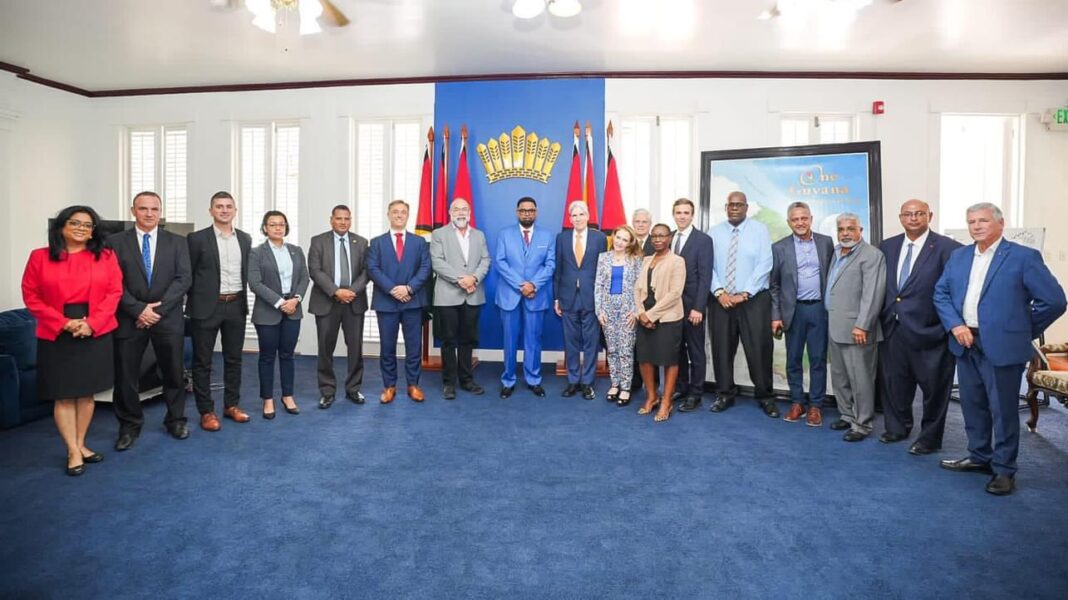
The idea of “Tomorrowland” has traditionally been one of sci-fi novels – a futuristic city that serves as a hub of technology, commerce and sustainability. This era of smart cities may now finally take place, and the University of Miami’s School of Architecture is already charting the course in Guyana.
The roots of Silica City, the name of this soon-to-be village, were planted over nine months ago through a dialogue with the government of Guyana and UM’s administration. The plan aims to prioritize the integration of industrial, digital, biomedical and AI sectors within its urban fabric, all within an 11,000-acre area near the Guyana International Airport.
As recently as Nov. 22, President Julio Frenk met with President of Guyana Irfaan Ali alongside other UM colleagues and officials to refine the goals of the project ahead and sign an agreement for the collaboration.
School of Architecture Dean Rodolphe el-Khoury, one of the main leaders behind this endeavor who also attended this meeting, shared insights into the origins and unique opportunities presented by the avant-garde project.
“Cities around the world are being transformed by the introduction of new technology. They are becoming more responsive and resilient, with a capacity to respond to data collected in real time,” said el-Khoury. “The difference here is the potential for integrating new technology and best practices in sustainable and resilient design into the plan of the city from the outset. So we are not retrofitting, but rather building in this new functionality and capacity into the very foundations of the city.”
Professor Jose Gelabert-Navia, leading an exploratory design studio course, also played a pivotal role in initiating this vision. His specialties in Latin American architecture as well as architectural history, world art, and globalization each aligned with the project’s overall niche.
“When the dean asked me to help lead the effort, I thought it was an extraordinary opportunity because this project has allowed us to introduce ourselves to the government of Guyana,” said Gelabert-Navia. “If all goes well, there is an opportunity for really developing long-term relationships and collaborating on more meaningful projects.”
The Guyana Innovation Group acted as the catalyst for this collaboration, with one of its members, Rodrigo Arboleda, on the Dean’s Advisory Committee of the School of Architecture. The partnership reflects the University’s commitment to pushing the boundaries of architectural exploration and fostering sustainable development on a global scale.
Guyana is also home to the fastest-growing economy globally according to the BBC, with over 11 billion barrels of oil being found within the region in the past decade. It has also gained the attention of many Fortune 500 companies with the development of another, smaller smart neighborhood, Innovation Village.
However, there are some concerns that pose obstacles ahead as Guyana continues to develop its newfound wealth. The country’s oil-rich neighbor, Venezuela, has begun initiatives attempting to exploit Essequibo, the Guyana region where its oil and gas mines are located.
The global trend to turn away from fossil fuels and achieve “net zero” greenhouse gas emissions by 2050, in accordance with the Paris Agreement, is also a concern for the Guyana government hoping to capitalize on this newly discovered resource.
But despite these concerns, UM and the government of Guyana are excited for what the development of Silica City means in terms of being one of the first hubs in the world to prioritize the industrialization of AI and sustainability, both of which are rapidly-advancing sectors in the global economy.
“What is interesting to us is, like a lot of the oil rich countries in the Middle East, they already have realized that eventually these fossil fuels are not exactly the best things,” said Gelabert-Navia.
“And the fact that they have the riches, but they also have the danger of actually doing more damage to the planet is an interesting line to walk. So they want to do this city as a model city, and that’s where we come in. There’s no equivalent to this anywhere else, and we have a unique opportunity to help them with this initial effort.”
According to el-Khoury, UM aspires to go beyond simple innovation, instead becoming a leading contributor to global advancements. By building a city designed for the future, the University positions itself at the forefront of urban development at a level usually reserved for other national governments.
Within the ambitious framework of Silica City, the School of Architecture has several ideas aimed at reshaping fundamental aspects of urban living, extending into housing, education and healthcare.
“Silica City allows us to rethink healthcare on a vast scale, optimizing the built environment for sustaining health and well-being,” el-Khoury said. “You can sense the swelling wave and it’s a pleasure to be part of it, especially given the attention of the government to issues of social and environmental justice. There is a great deal to be done during this period of growth, and it’s important that we do it right.”
As Silica City’s design process begins, the interdisciplinary team is being assembled, featuring students, faculty, research staff, and external consultants. Dean el-Khoury anticipates the involvement of various UM units, drawing on expertise from civil engineering to public health.
Professor Gelabert-Navia argues that as the dream of Silica City begins to materialize, it symbolizes not only architectural innovation, but a testament to the fusion of academia, sustainability and global cooperation.
“The unique opportunity we have is coming in as a mindful collaborator,” said Gelabert-Navia. “Because we’re an educational institution, we’re not there to make money off of them. We’re offering them what they want, which is ultimately a collaboration where they can move forward. I’m hoping it’s a win-win for everyone involved.”






